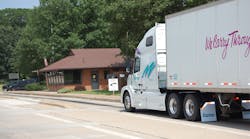How much does it cost, in terms of lost productive time, a freight-hauling truck when it gets pulled into a weigh station? And does that cost fluctuate, depending on the time of the year or the particular state where the weigh station is based?
Those are questions Drivewyze, which offers a pre-clearance weigh station bypass service, sought to answer when it analyzed some 13 million individual “site visits” across the U.S. between September and October last year.
The answer: The average weigh station visit took 3 minutes and 37 minutes, costing a truck $9.26 in lost productive time per pull-in, according to Doug Johnson, director of marketing for Drivewyze.
“We wanted calculate the cost of that weigh station pull-in in terms of the time it took to exit and then re-enter the main highway line,” he explained to Fleet Owner during an interview at the 2016 Mid America Trucking Show last week.
Johnson emphasized that analysis shows that the cost of minutes can “add up quickly” in trucking depending on the frequency of weigh-station pull-ins.“Carriers know how often they get inspected but they don’t know how often they just get pulled-in and then waved through,” he stressed.
Based on Drivewyze’s analysis, roughly 25% of trucks being pulled into weigh stations are in and out in less than a minute; thus they don’t experience must of a cost impact, Johnson noted.
Another 25% are in and out between 48 seconds and 1 minute and 18 seconds, whereas another 25% range from 1 minute 19 seconds to two minutes and 21 seconds. The final grouping runs from 2 minutes and 21 seconds to 8 hours, at which Drivewyze cut off its time-tracking metric.
Johnson also noted that average weigh station pull-in times varied significantly by state, with Massachusetts the highest at 6 minutes and 33 seconds, followed by Wyoming at six minutes and 32 seconds, New York at 5 minutes and 47 seconds, Pennsylvania at 4 minutes and 24 seconds, and West Virginia at 3 minutes and 44 seconds.
Yet he added that those numbers may actually change depending on the time of the year or due to enforcement events – such as the annual brake safety inspection blitz spearheaded by the Commercial Vehicle Safety Alliance (CVSA).
“That’s why we can’t accept those figures as ‘true’ monthly averages; we can’t treat them as ‘gospel,’” he stressed. “That’s why plan to look at these numbers on a quarter by quarter basis. We also expect to see a lot more variability by state as well.”
Johnson added that some states don’t operate many weigh stations, so a bypass system may not benefit trucks on particular routes.
However, for fleets operating in states with many weigh stations, or for truckers driving along routes highly populated with them, the savings for bypass technology can add up in a hurry.
“We had one truck in Minnesota that bypassed a weigh scale on I-94 by the St. Croix Bridge 14 times a day,” he explained. “That saved 13 hours or $2,005 per month for just that one truck.”
The point is, Johnson stressed, is that states don’t need to see “the good fleets” so the ability to bypass weigh stations – especially when they are heavily congested – is a win/win for all involved, truckers as well as state enforcement agencies.
“Weight stations are not getting less busy,” he emphasized.




